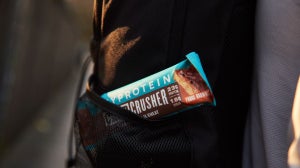Daniel Speakman
Writer and expert4 years ago

The original go-to exercise for developing a wider back, lat pulldowns are the perfect move to bring out your latissimus dorsi (lats) and build that V-shaped back.The lats, or wings as they’re commonly known, are one of the biggest muscles in the back and are responsible for shoulder adduction and extension — helping to pull the arms in towards and behind the body.Lat pulldowns are a popular exercise in the fitness world. Used by Arnold Schwarzenegger as part of his ultimate muscle-building back workouts, they’re now performed by everyone — from fitness influencers to the everyday gym-goers. Let’s take a look why…
What is a lat pulldown?
We’ve all seen a lat pulldown machine in the gym and there are many different variations and attachments you can use.This is a compound movement, working the latissimus dorsi (lats for short), but your biceps will play an assisting role also. It sounds simple in theory, you keep your chest out and pull down to your upper chest, using a wide grip. As this exercise is done on a machine, you don’t have many of the risks associated with free weights, however, we do still need to make sure it’s performed correctly in order to get the best possible results.
How to perform a lat pulldown
https://youtu.be/5M-r6X9wMGo
1. Make sure the wide-grip bar is attached. Adjust the knee support so your legs feel locked in.2. Take a firm grip of the bar with your palms facing forwards (overhand grip). They should be wider than shoulder-width apart.3. Lean back very slightly (approx. 20 degrees), lift your chest and keep your torso tight.4. Pull the bar down to your upper chest, squeezing your shoulder blades together. Make sure your elbows move downwards and not backwards behind you.5. Slowly release the weight back to the starting position, fully extending your arms and stretching your lats.6. Repeat for your full set.
Top Tips:
- Focus on squeezing your back muscles for maximum contraction.
- Your upper body should remain stationary throughout.
- Your elbows should point down towards the floor.
- Use a thumbless grip to take out some of the bicep work.
The benefits of a lat pulldown and the muscles worked
Aesthetics:
One of the benefits of this exercise is that it is deemed as “the back builder”, and for good reason. The lats take up the majority of your back, so you can really work on that V-taper look as well.Strength:
Whilst we perform this exercise, we are really strengthening our back. This one movement uses multiple muscles in the upper back.Engages multiple muscles:
The other muscles engaged while performing this exercise are the posterior deltoids (rear delts), rhomboids, and trapezius, the biceps also play their part.
Common mistakes and how to fix them
Pulling the bar down past your chest
Pulling the bar way past your chest and almost in line with your stomach takes almost all the tension away from the lats and back. You can avoid this by keeping your chest high and stopping when you reach your upper chest.
Swinging
Swinging the weight backwards in an attempt to build momentum also takes all of the tension away from your back muscles — so you’re essentially not using them! Keep your chest upright and maintain a good posture. Keep as stationary as possible throughout.
Shrugging the shoulders
This is a clear sign the weight is too heavy for you. As you pull the weight down your shoulders will lurch forward like a shrug. During the movement, your shoulder blades should actually stay down, with your elbows by your side.
Variations and alternate exercises to the lat pulldown
Pull-ups
https://youtu.be/HqCIvm5l9IA
Pull-ups are another great back builder and almost mimics the lat pulldown. This movement will give you fantastic width over time. Pull-ups are notoriously difficult, so if you don’t do them regularly, you can use the assisted pull-up machine to build up your strength. Take a grip, with your hands around shoulder-width apart, hang from the bar and raise your feet or bend your knees. Pull yourself up so your elbows point to the floor so your chin reaches or passes the bar you are hanging from.
Negative pull-ups
https://youtu.be/zjLQXH30yUc
The negative pull up helps to increase grip and overall strength, which can benefit your regular pull-ups. It involves performing only the lowering, or eccentric, phase of the exercise. This also helps your stabilizing muscles, which again helps aids massively with pulls upsWe can start off by standing on a box or bench. Reach for the bar or jump up and take a shoulder-width grip. Once you have gripped the bar, lower yourself down as slowly as you can, stretch out your lats and keep your core tight. Once you reach the bottom, step back onto the box or bench and reach up again, repeating the movement. Try to do this exercise whenever you are doing any sort of pull session. Over time, you will notice your pull-ups improve.
Bent-over barbell rows
https://youtu.be/l1hZkB37X_8
Bent-over dumbbell rows will also work your lats and multiple back muscles. This is a popular compound exercise, which you can (and should) add into your back or pull sessions. As you're in a bent-over position, using the correct form is key to avoiding injury. So, keep your back straight and almost parallel to the floor. Don’t stand too upright, as you risk turning this from a bent-over row into an upright row. Keep your knees bent and your torso positioned forward slightly. Lift the weight to your sternum, keeping your elbows tucked in and close to your body.
Take home message
Lat pulldowns are referred to as the back builder, and your lats as “wings”. This is because your lats and the pulldown give you the width you need for a strong back and physique, not to mention that V-taper that everyone wants. You can really develop your back with this exercise, so I would add it into your back sessions at least once per week, or even twice. Make sure your form is correct and the weight suits where you're up to with your training. Increase over time once you're comfortable and reaching higher rep ranges like 12-14 reps. As mentioned earlier, this exercise is for all levels of gym-goers and most gyms will have this machine.Make sure you also try the alternative exercises because, like any other movement, over time you can plateau. So, keep mixing things up. This can be as little as just changing the attachments or even just the weights and number of reps you complete.
Daniel Speakman
Writer and expert

Dan Speakman is our editor and level 3 qualified Personal Trainer. Having spent time in Australia, he has experience in planning and delivering exercise plans to beginners and advanced athletes — both in the UK and down under.
Dan has also run successful weight-loss camps across the UK, alongside regular training seminars, covering all areas of gym-based training. He also runs weekly fitness boot camps and spin classes.
When he’s not working, or in the gym, Dan enjoys travelling to sunnier destinations, eating out, and trying exciting new foods.




